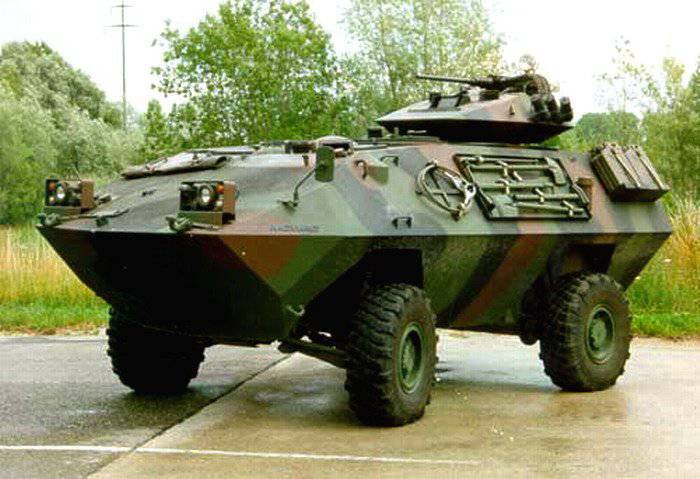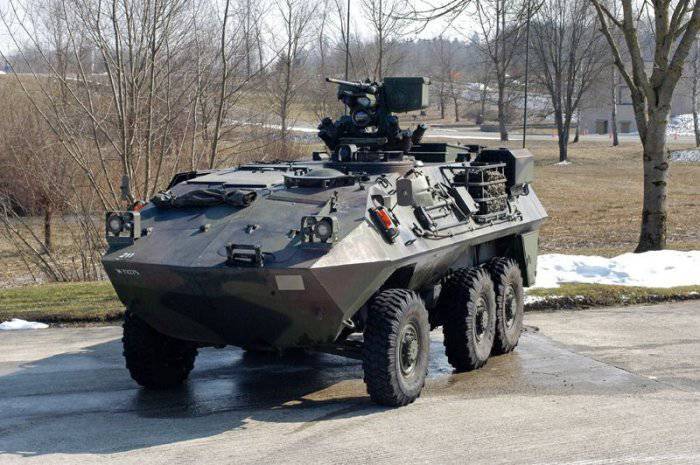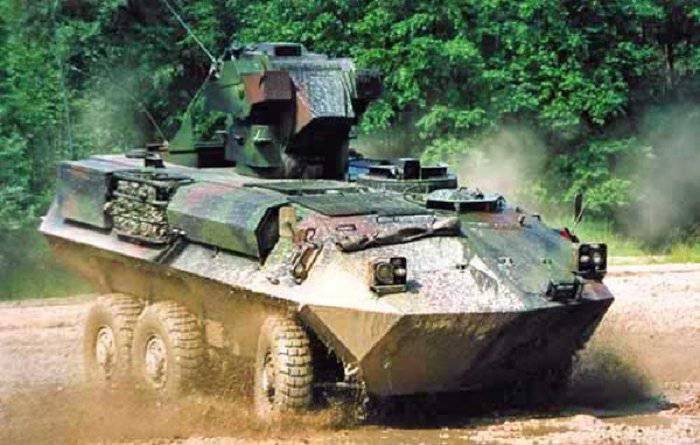Armored cars of the Piranyev family. Part I
Piranha 4x4
The first representative of the future family was the armored car "Piranha 4х4", later also received the designation Piranha I. It was a four-wheel all-wheel-drive armored car with a combat weight of about seven tons, designed to carry up to nine people. Protection of the crew of two people, troops of seven, as well as components and assemblies of the car itself was carried out with the help of an armored hull. The maximum thickness of its plates was 10 millimeters, which provided all-view protection from conventional bullets caliber 7,62 millimeters. The front plates of the machine, in turn, defended against armor-piercing bullets of the same caliber. The landing and disembarking of the crew with the landing force was carried out only through double doors in the stern of the vehicle.

The power plant of the very first "Piranha" has undergone several changes. Initially, taking into account export prospects, the proposed gasoline engine power up to 200 horsepower. A little later, the appearance of a promising car changed and as a result, a six-cylinder diesel Detroit V4 with an 4 hp power was installed on the Piranha 6x216. The engine had a water cooling system and was equipped with a turbocharger. The torque was transmitted from the engine to the wheels through a manual gearbox and transmission manufactured by Chrysler. For movement on the water, Swiss engineers have provided two propellers in the rear of the machine. The wheels of the car had a torsion (front axle) and spring (rear) suspension. In addition, hydraulic shock absorbers were provided on all wheels. Applied to the "Piranha" powerplant and chassis ensured her excellent driving performance. On the highway, the armored car accelerated to one hundred kilometers per hour. Propellers provide water speed in 9-10 km / h. A two hundred liter fuel tank was enough to march along the highway up to 750 km.
Armament armored Piranha 4x4 consisted of a single machine gun caliber 7,62 or 12,7 mm. The choice of the type of machine gun remained for the customer. Any suitable weapon installed on a special turret above the small turret on the roof of the car. A characteristic feature of the weapons of the first "Piranha" was the remote control system. Guidance, aiming and machine gun fire could be conducted while remaining under the cover of armor. Additional firepower provided personal assault weapons. For this purpose, there were four ball mounts of the original design in the sides of the hull. Two more housed in the stern door. When developing them, some features of armored vehicles of that time were taken into account. In this regard, Piranha 4x4 became the first European armored vehicle, whose embrasures allowed you to fire even in the conditions of using weapons of mass destruction. The original design of ball mounts with movable shutters and a remotely controlled machine gun turret were patented and later repeatedly used on other armored vehicles.
The first "Piranha" became the basis for several machines for various purposes. This is a command-staff armored car with additional communications equipment and related equipment, a communications vehicle, as well as an armored truck. In the latter case, all the differences lay in the layout of the troop compartment, which had a smooth floor without any projections and easily removable seats for the landing. However, the presence of modifications almost did not affect the success of the armored car. All deliveries were limited to 80-th machines for Argentina (called Grenadier), as well as a number of armored vehicles for Liberia. In general, the project Piranha 4x4 can not be called completely successful. When using a number of original solutions, the armored car did not receive particular advantages over its competitors, including cheaper ones. For this reason, the total number of cars built barely moved through the bar in one hundred pieces.
Piranha 6x6
A little later, the start of work on the four-wheel armored vehicle project began designing his “brother” with the wheel formula 6х6. The alternative name of the armored vehicle - Piranha II. It should be noted that the name system using Roman numerals appeared much later than the armored car family itself, which sometimes leads to some confusion. The six-wheeled armored car was not originally created as an export vehicle. The management of the company MOWAG still hoped to push its new development into the Swiss army, for which several steps were taken.
First of all, the dimensions of the car were chosen so that it could move freely on the roads of Switzerland, including mountain serpentines. Thanks to this, the “Piranha” with a length of about six meters could easily not only drive on all the roads of the country, but also turn around on narrow mountain roads without risking to break or even touch the fence. The second feature to ensure work in mountain conditions was the choice of the engine. 300-strong diesel Detroit V6-53T equipped with a turbocharging system that ensures engine performance at altitudes up to five thousand meters above sea level. The power of the diesel engine was transmitted to all wheels through an Allison transmission, the automatic transmission with four forward and one reverse gears. The final step to adapt the "Piranha 6x6" to work in the mountains was the refinement of the suspension. At this time, the front two wheels received a spring suspension, and the rest - torsion bar. In addition, in the event of damage to the wheels of the armored car, two-compartment tires with reinforcement were obtained. As a result, the Piranha II armored car was able to operate normally in almost any European location. For crossing over the rivers and reservoirs, an armored car was equipped with two propellers in the stern. Next to the screws there were two plate-shaped rudders that controlled the vector of their thrust. Driving performance Piranha 6x6 were on the level of a four-wheeled armored car - the maximum speed on the highway to 100 km / h and up to ten on the water.
The armored hull of the Piranha 6х6 was made on the basis of the first armored car of the family. For this reason, the maximum thickness of the sheets, as well as the level of protection, remained the same - 10 millimeters, which protect against ordinary and armor-piercing bullets from rifle caliber. The layout of the internal volumes also did not change: the engine compartment in the right front of the hull, the driver’s workplace to the left of it and the troop compartment in the middle and stern parts. The own crew of the armored car has increased in comparison with the previous vehicle to three people (driver, commander and gunner). The landing remained the same - nine soldiers with equipment and weapons. Planting and disembarking was carried out through two doors in the stern. In this case, the commander and the driver got their own hatches in the roof.
The first Piranha 6x6 as the main armament received a remote-controlled turret with an 20-mm automatic gun mounted on it. As in the case of the Piranha 4х4, the specific type of weapon was chosen by the customer. Additional armament was not provided, but in the sides of the hull spherical installations were mounted for firing from the assault weapon. Later, when the six-wheeled "Piranhas" were exported, the range of possible weapons of this armored vehicle-armored personnel carrier was significantly expanded.
Despite the calculation of the developers, Piranha II did not immediately get into the Swiss army. Canadians were the first to be interested in her. In 1977, they ordered a number of ready-made armored personnel carriers, and then acquired a license for production and modernization. So the Grizzly armored personnel carrier appeared, armed with two coaxial machine guns of a caliber of 7,62 and 12,7 millimeters. Together with new weapons, a new turret had to be installed on the standard Piranha chassis. The next Canadian project, called Cougar, called for another turret and weapon replacement. This time, the Piranha 6x6 acquired a combat module with an English-made 76-mm L23A1 cannon. The tower was entirely borrowed from tank FV101 Scorpion. The latest version of the "Piranha 6x6" hailing from Canada was the Husky repair and recovery vehicle. Instead of a tower with armament, the BREM received a slewing crane, and a small repair shop with a supply of interchangeable parts was placed in the landing compartment.
Chile became the next customer of the six-wheeled "Pirani". When purchasing ready-made armored cars, a South American country chose a production license, which was deployed at the Cordoen factory. Before 1983, about fifty armored vehicles with various weapons were assembled. On the basis of the original tower of the Swiss design, a combat module was created with Oerlikon's 20-mm cannon. Another tower of its own design already carried two guns from Hispano-Suiza of the same caliber. This version of the armored vehicle, primarily intended for air defense of army units. It is particularly noteworthy that the Chileans, despite the small amount produced under the license of Pirani, managed to test on them a great number of weapons, from machine guns to anti-tank guns. 76- and 90-millimeter cannons, as well as recoilless guns of the caliber 106 mm, were mounted on the turrets of their own designs. Finally, several vehicles were equipped with launchers for Red Arrow anti-tank missiles and related equipment.
As we see, despite the initial plans of the company MOWAG, Piranha 6x6 could not immediately interest the main, as it was seen, customer - the Swiss army. The armed forces of this country have been thinking and reflecting on the profitability of such a machine for almost ten years. Only in 1986, a contract was signed for the supply of 310 new armored vehicles in various configurations. The bulk of the ordered cars had to be built in the original version of the armored personnel carrier. In addition to them, the order meant the delivery of a certain number of anti-tank machines based on the Piranha 6x6. Initially, MOWAG presented the AFV-90 machine for this “position”. The standard Arrowpoint 90 turret with a Mecar Kenerga 90 mm caliber gun and a barrel length in 46 caliber was installed on a standard armored vehicle body. Also this project meant strengthening the protection of the hull. However, the barrel anti-tank complex lost the competition with another project of the same company. An alternative to AFV-90 was the Panzerjager-90 combat vehicle, armed with BGM-71D TOW-2 anti-tank missiles. The special turret housed two missile launchers. The ammunition of the machine was eight shots. Despite a number of dramatic differences from AFV-90, such as weapon type, less powerful protection, relatively small ammunition and considerable loading time (about 45-50 seconds per each rocket), the Panzerjager-90 was recognized as the best machine. First of all, the range of confident fire affected - the guided missile flew at a distance of up to four kilometers, and its armor penetration rates did not change throughout the flight. In the future, "Panzergary" received missiles of new models.
Armored vehicles Pirahna 6x6 in various configurations for the first time took part in battles during peacekeeping operations in the Balkans in the mid-nineties. In general, the experience of practical application fully confirmed all the concerns expressed at the development stage of machines. The armored hull provided full protection only for the first level of the STANAG 4569 standard. The front sheets of the case "Pirani" at the very least pulled to the second level, but at least about such protection from all angles, even the speech did not go. In this regard, several security enhancement projects have been developed related to the installation of additional booking modules. When developing new Piranha cars, this experience was taken into account.
Sources:
http://mowag.ch/
http://army-technology.com/
http://warwheels.net/
Nikolsky M.V., Ilyin V.E. Wheel armored vehicles. - M .: Astrel / AST, 2001


Information